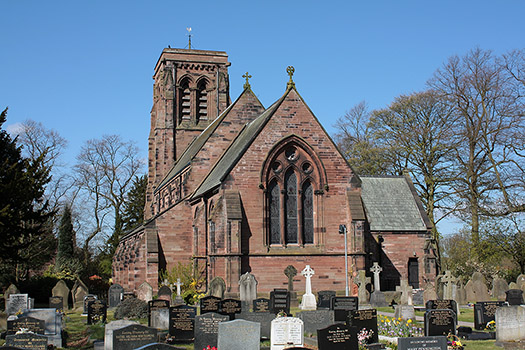 |
 |
|
| St. Matthew's, Stretton | St. Matthew's |
 |
 |
|
| St. Matthew's, Stretton | St. Matthew's |
The church at Stretton dates from 1870 but the history of the site is much older. The Starkie family were lords of the manor from the 12th century and it is thought there was a family chapel built in the 13th or 14th century. A document in the early 16th century mentions an oratory. Sir Peter Leicester, in his History of Cheshire, mentions an ancient chapel at Stretton in decay in the 1660s. In about 1826-7 a Church Commissioners' church was built by Philip Hardwick as a chapel of ease for Great Budworth. Richard Greenall of the brewing family commissioned George Gilbert Scott to build a new chancel in 1859 but Greenall died in 1867 and the rest of the church was rebuilt as a memorial to him with Scott as the architect. The church does not feature in Richards' Old Cheshire Churches.
Sir Peter Leicester reports that Roger Fitz-Alfred granted Stretton to Richard Starkey in the reign of King John. This same Roger Fitz-Alfred had a daughter who married Adam de Dutton the ancestor of the Warburtons of Arley Hall. The Starkey family subsequently branched into two, those at the Lower or Nether Hall and those at Over Hall in the late 13th century and early 14th century. Richard Starkey of Lower Hall had a younger brother Randle both living in the time of Edward III. By the time of Leicester's writing in the 1660s, many parcels of land of the Starkeys in the Stretton area had been sold. but he reports that this family were the ancestors of the Starkeys of Wrenbury and Olton (Oulton).
By the time Ormerod was writing in the early years of the 19th century, the Starkey family of Upper or Over Hall had died out. The Thomas Starkey who was lord of the manor in 1650 was succeeded by his eldest son Thomas, who died without issue. The next son, Philip succeeded to the manor and estates, of which a large part had been lost in the Civil War. Philip died in 1714 and was succeeded by his sister, Christian, the wife of Peter Starkey of Warrington and by Joseph Coppock his nephew. The latter was the son of Frances Starkey. The Lower Hall was sold in 1719 to Henry Wright of Mobberley.
Christian Starkey passed her share to the Ann, the widow of her brother-in-law Thomas Starkey, who passed it on to Thomas son and heir of Joseph Coppock. On the death of Joseph Coppock his son Thomas became sole heir. Thomas by his will of 1749 arranged for the estate to be divided and sold and the manor passed first to his eldest son, David Starkey Coppock, who died in infancy. He was succeeded by his brother Thomas Coppock who was drowned off Gibraltar after falling overboard from a frigate. His eldest sister Grace died without issue but the second sister, Catherine, who had married Michael Renwick, a surgeon in Liverpool, had one surviving son, Thomas Renwick MD, born 7 July 1767, who was the proprietor at the time Ormeod was writing.
Ormerod notes that all the estates of the Lower Hall were eventually purchased by Henry Lyon of Appleton Hall who became patron of the church. The Lyon family became involved in banking in a partnership with the Parrs. Below I show an abbreviated version of the family tree adapted from that in Ormerod's History of Cheshire, volume i page 667, to show the last few generations at Lower Hall and the descent to the Coppock and Renwick families.
The Buildings of England: Cheshire, by Nikolaus Pevsner and Edward Hubbard, first edition 1971, Yale University Press edition in 2003.
Ormerod's History of Cheshire.
Wikipedia